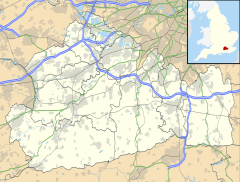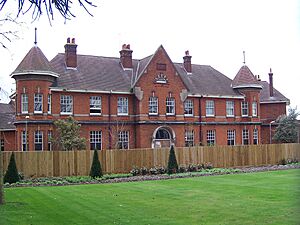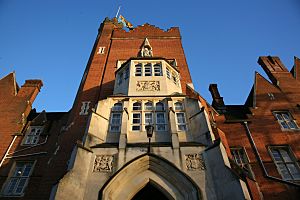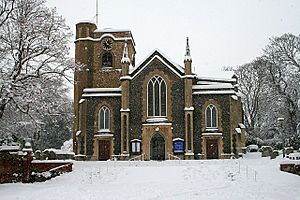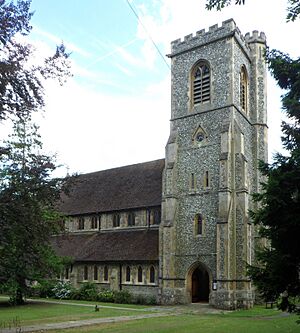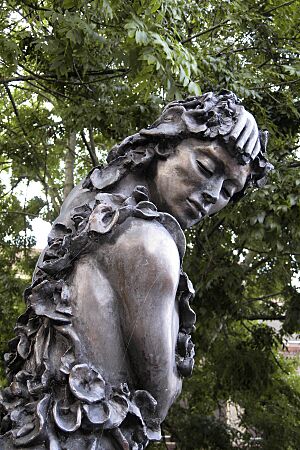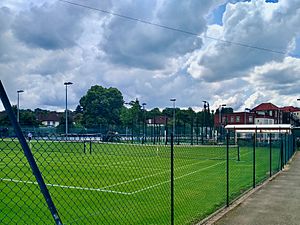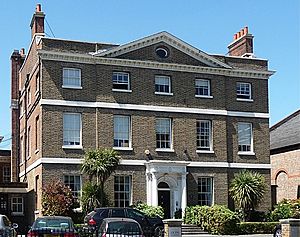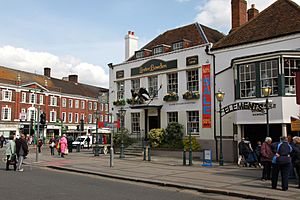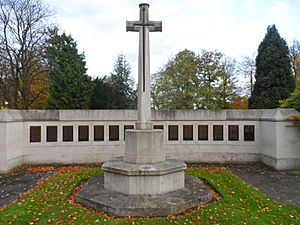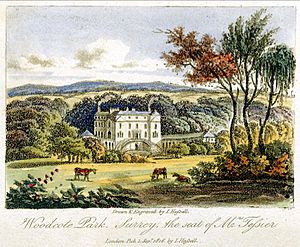Epsom facts for kids
Quick facts for kids Epsom |
|
|---|---|
| Town | |
 Epsom Clock Tower, High Street |
|
| Area | 18.04 km2 (6.97 sq mi) |
| Population | 31,489 (2011 census) |
| • Density | 1,746/km2 (4,520/sq mi) |
| OS grid reference | TQ2060 |
| District |
|
| Shire county | |
| Region | |
| Country | England |
| Sovereign state | United Kingdom |
| Post town | Epsom |
| Postcode district | KT17, KT18, KT19 |
| Dialling code | 01372 |
| Police | Surrey |
| Fire | Surrey |
| Ambulance | South East Coast |
| EU Parliament | South East England |
| UK Parliament |
|
Epsom is a town in Surrey, England. It is about 22 kilometres (13.5 miles) south of central London. The town's name, Ebesham, was first written down in the 10th century. It likely comes from a Saxon landowner's name.
People have lived in this area since the mid-Bronze Age. The modern town probably started around St Martin's Church in the 6th or 7th centuries. Its street layout was likely set up in the Middle Ages. Today, the High Street has a tall clock tower built in 1847–48.
Epsom is on a "spring line." This is where soft chalk hills meet hard London Clay. Several small rivers start here. In the 17th and 18th centuries, a spring on Epsom Common was thought to have healing powers. Its water was rich in "Epsom salts," which we now know as magnesium sulphate.
Even King Charles II visited to "take the waters." Famous writers like John Aubrey and Samuel Pepys also wrote about their visits. But by the 1720s, Epsom's popularity as a spa town quickly dropped. Other towns like Bath became more popular.
Horse racing has happened on Epsom Downs since the early 1600s. The town became more famous when The Oaks race started in 1779 and The Derby in 1780. The first big building for watching races was built in 1829. In 1843, over 127,000 people came to Derby Day. Sadly, during the 1913 Derby, suffragette Emily Davison was badly hurt by a horse and later died.
The first railway station opened in Epsom in 1847. This, along with the breaking up of a large estate, helped the town grow. Today, Epsom station is an important train hub. It connects lines to London Victoria and London Waterloo. Since 1946, the town has been surrounded by a Metropolitan Green Belt. This limits how much it can grow. Two local nature reserves, Epsom Common and Horton Country Park, are west of the town. Epsom Downs, to the south, is a special area for nature.
Contents
- What's in a Name? The History of Epsom's Name
- Epsom's Location and Landscape
- Epsom Through Time: A Brief History
- Epsom's Population and Homes
- Public Services in Epsom
- Getting Around Epsom
- Learning in Epsom: Schools and Colleges
- Places of Worship in Epsom
- Culture and Arts in Epsom
- Sports and Recreation in Epsom
- Famous Buildings and Places in Epsom
- Parks and Green Spaces in Epsom
- Well-Known People from Epsom
- Images for kids
- See also
What's in a Name? The History of Epsom's Name
The first time Epsom was written down was in the 10th century as Ebesham. In the Domesday Book of 1086, it was called Evesham. Over time, its name changed many times, like Epsam and Epshome. The way we spell "Epsom" today first appeared in 1718.
The name "Epsom" likely comes from a Saxon landowner named Ebba or Ebbi. So, it could mean "Ebba's home" or "Ebbi's home." Another idea is that it comes from an Old English word, ebbe, meaning "flow." This might refer to a spring or stream in the area.
Epsom's Location and Landscape
Epsom sits on two different types of land. The northern part of town has gravel and sand over London Clay. The south-east part is on chalk slopes. These slopes reach up to a wide flat area called Epsom Downs.
The northern soil is good for farming and forests. The southern soil is either thin and chalky or slightly acidic and clayey. The main part of Epsom is between 35 and 70 metres (115 to 230 feet) above sea level. It gently slopes down from the south towards the centre. The racecourse and Langley Vale areas are higher, reaching 140 metres (460 feet).
Nearby Towns and Villages
 |
Hook West Ewell, Ewell |
Ewell | Cheam Sutton |
 |
| Chessington | Banstead | |||
| Ashtead | Walton on the Hill | Tattenham Corner |
Epsom Through Time: A Brief History
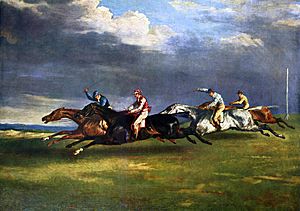
Epsom was part of a "hundred" called Copthorne. This was an area used for important meetings in Anglo-Saxon England. Many towns in Anglo-Saxon England were built near springs, like Epsom. A brooch from the 7th century, found in Epsom, is now in the British Museum.
In 933, Chertsey Abbey owned the main estate in Epsom. The Domesday Book of 1086 shows Epsom had 11 "hides" (a measure of land), two churches, two mills, and lots of farmland and woodland. It had 38 households. Over time, other estates were created in areas like Horton and Woodcote.
Later, the ownership of the main estate passed through several important families. By the end of the Georgian period, Epsom was well-known as a spa town. You can still see its old water pump and other items in the town's museum. There were fun places like the Assembly Rooms, built around 1690.
Epsom salts are named after the town. They were first made by boiling down the mineral waters from Epsom's springs. The town's market today is built on what used to be a pond in the Middle Ages.
Epsom is home to Epsom Downs Racecourse. This is where two of England's biggest horse races happen: The Derby and The Oaks. These races started in 1780 and 1779. In 1913, Emily Davison, a woman fighting for women's right to vote, stepped in front of King George V's horse during the Derby and died from her injuries.
Lord Rosebery, a British Prime Minister, was expelled from University of Oxford in 1869 for buying a racehorse and entering it in the Derby. He stayed connected to Epsom his whole life. He gave land to the town, which is remembered in names like Rosebery Park and Rosebery School.
Epsom's Population and Homes
In the 2011 Census, Epsom had a total population of 31,489 people. The town is divided into different areas called wards.
| Ward | Population | Households | % Owned outright | % Owned with a loan | hectares |
|---|---|---|---|---|---|
| College | 5,873 | 2,248 | 41.1 | 35.9 | 316 |
| Court | 6,830 | 2,567 | 13.8 | 39.8 | 213 |
| Stamford | 6,088 | 2,348 | 38.5 | 43.7 | 436 |
| Town | 6,979 | 3,154 | 27 | 29.1 | 136 |
| Woodcote | 5,719 | 2,286 | 41.4 | 37.9 | 703 |
| Regional average | 35.1 | 32.5 |
| Ward | Detached | Semi-detached | Terraced | Flats and apartments | Caravans/temporary/mobile homes/houseboats | Shared between households |
|---|---|---|---|---|---|---|
| College | 1,040 | 425 | 144 | 622 | 0 | 17 |
| Court | 160 | 721 | 947 | 738 | 1 | 0 |
| Stamford | 707 | 995 | 300 | 346 | 0 | 0 |
| Town | 237 | 849 | 455 | 1,584 | 2 | 27 |
| Woodcote | 1,111 | 513 | 232 | 430 | 0 | 0 |
Public Services in Epsom
Utilities: Power, Water, and Gas
Epsom got its first public gas supply in 1839. Gas streetlights were put up in the town centre by 1840. The town's waterworks started in 1853. Before that, waste often polluted drinking water. A proper sewerage system was built in 1854.
An electricity station opened in 1902. It could make 220 kilowatts of power. By 1939, it could make 2 megawatts. Epsom was connected to the National Grid in 1926.
Emergency Services and Justice
Epsom had a courthouse built in 1848, but it closed in 2010. The Epsom Police Station opened in 1963. The police force became part of Surrey Police in 2000.
Epsom likely had a fire engine around the 1760s, run by volunteers. The first full-time fire brigade started in 1870. The current fire station opened in 1937. The South East Coast Ambulance Service runs Epsom Ambulance Station.
Healthcare in Epsom
Epsom Cottage Hospital opened in 1873. It moved to a new building in 1889. Emily Davison died there in 1913 after the Derby accident. The hospital closed in 1988 but is still used for therapy.
Epsom Hospital was built in 1890. It became part of the NHS in 1948. It has an A&E department (Accident & Emergency).
The Epsom Cluster was a group of five psychiatric hospitals built west of Epsom. The first, the Manor Asylum, opened in 1899. All these hospitals closed in the 1990s and 2000s. Their sites are now used for homes.
Getting Around Epsom
Bus Services
Epsom has many bus routes connecting it to nearby towns and villages in Surrey and south London.
Train Connections
Epsom railway station is just north of the town centre. It was rebuilt in 2013. Trains from Epsom go to London Victoria, London Bridge, London Waterloo, Horsham, and Guildford.
Walking Trails
The Thames Down Link is a long walking path. It runs between Kingston upon Thames and Box Hill. This path goes through Horton Country Park and Epsom Common.
Learning in Epsom: Schools and Colleges
Further and Higher Education
The Epsom campus of the University for the Creative Arts started in 1896. It was first called the Epsom Technical Institute & School of Art. It moved to a new building in 1973. In 2005, it became part of the University for the Creative Arts.
Laine Theatre Arts is a performing arts college. It was started by Betty Laine in 1974. Students learn dance, singing, and acting for careers in musical theatre. Famous people like Victoria Beckham and Kerry Ellis studied here.
Local Schools
Blenheim High School opened in 1997. It became an academy in 2012.
Glyn School started as Epsom County School in 1927. It became a grammar school in 1944. It changed to a comprehensive school in 1976 and an academy in 2011.
Rosebery School opened in 1921. It moved to its current site in 1927 on land given by Lord Rosebery. It became an academy in 2011. Both Glyn and Rosebery schools are part of GLF Schools.
Independent Schools
Epsom College was founded in 1851 by a doctor named John Propert. It was first for sons of doctors. The school buildings opened in 1855. Girls were first allowed in 1976, and it became fully coeducational in 1996.
Kingswood House School is a preparatory school west of town. It started in 1899. Girls were admitted for the first time in September 2021.
Places of Worship in Epsom
St Martin's Church
One of the two churches mentioned in the Domesday Book might have been where St Martin's Church is today. The oldest part of the church is its flint tower, from around 1450. Most of the church was rebuilt in 1824. The 15th-century spire was damaged in a storm in 1947 and removed.
The church has old memorials, including some by the sculptor John Flaxman. It also has a copy of the "vinegar bible" from 1717.
Christ Church
Christ Church started as a smaller church for St Martin's in 1843. In 1874, Epsom parish was split, and this church became the main church for Epsom Common. The current church, designed in the Gothic revival style, opened in 1876.
The church has a mural of Christ and a beautiful rood screen made of wrought iron and bronze. The inside of the church was changed between 1987 and 1995 to make it more flexible.
United Reformed Church
After 1662, non-Church of England Christians met in small groups. They built their first meeting house in Epsom in 1720. A new church was built on the same spot in 1905. A fire destroyed much of it in 1961, but it was rebuilt two years later. It became Epsom United Reformed Church in 1972.
St Joseph's Catholic Church
The Catholic church of St Joseph started in 1859. The first church was built in 1866. It was extended in 1930. A new, larger church was built in 1999 and opened in April 2001.
Culture and Arts in Epsom
Plays and Books
Epsom Wells, a play by Thomas Shadwell, is set in Epsom. It was first performed in 1673.
Epsom Downs, a play by Howard Brenton, is set at the 1977 Epsom Derby. It was first performed in 1977.
Music Groups
Epsom Choral Society was started in 1922. The Epsom Symphony Orchestra, for amateur musicians, began in 1951. It performs four concerts each year. The Epsom & Ewell Silver Band, a traditional British brass band, was founded in 1910.
Art and Paintings
The painter John Constable visited Epsom often between 1806 and 1812. He painted several scenes of the town, including View at Epsom (1809). The Tate gallery owns his work and paintings of horse racing on the Downs. The 1821 Derby at Epsom (1821) by Théodore Géricault is in The Louvre museum.
Public Artworks
A small statue by Australian sculptor Tom Merrifield was put up outside the Playhouse in 1999. It shows the dancer John Gilpin.
Evocation of Speed, a bronze sculpture by Judy Boyt, was placed in Epsom Square in 2002. It shows two famous racehorses, Diomed and Galileo.
A statue of Emily Davison by artist Christine Charlesworth was put in the marketplace in 2021.
Theatre Performances
Epsom Playhouse opened in 1984. It has two performance areas. The main theatre seats up to 450 people. The Myers Studio is smaller, seating 80, and is good for plays, comedy, and jazz.
Sports and Recreation in Epsom
Rainbow Leisure Centre
The current Rainbow Leisure Centre opened in 2003. It has swimming pools, dance studios, and a sports hall. In 2011, a spa was added. The centre is managed by "Better."
Football
Epsom & Ewell F.C. started as a cricket club in 1918. A year later, they began playing football. They changed their name to Epsom Town F.C. in 1922 and then to Epsom F.C. in 1934. Since 2020, they play at Fetcham Grove.
Cricket
People have played cricket in Epsom since 1711. Epsom Cricket Club was likely founded around 1800. They play their home games on Woodcote Road.
Hockey
Epsom Hockey Club plays in the London Hockey League. It was probably founded around 1900. They play their home games on Woodcote Road.
Tennis
Epsom Lawn Tennis Club started as a croquet club in the 1850s. By the 1870s, tennis became more popular. In 1923, their last croquet court was turned into a tennis court.
Other Sports
Epsom and Ewell Harriers is a club for track and field athletes. Epsom Cycling Club, founded in 1891, is one of the oldest in the country. Sutton and Epsom Rugby Football Club started in 1881.
Famous Buildings and Places in Epsom
The Ashley Centre
The Ashley Centre is a shopping centre that opened in 1984. It was designed with steel, glass, and marble. Queen Elizabeth II opened it. It is named after Ashley Road.
Ashley House
Ashley House is a three-storey brick house built in the 1760s. It has a special central doorway. It is a Grade II* listed building, meaning it's very important.
Assembly Rooms
The Assembly Rooms were built around 1692 when Epsom was a popular spa town. It was a meeting place with a tavern, coffee house, and billiard room. It also had a bowling green. Today, it is a public house (pub).
Clock Tower
The Clock Tower's first stone was laid in 1847. It is 21 metres (70 feet) tall and made of red and grey brick. It used to have lion sculptures, but now has globe lights. The base was extended in 1920 to add toilets. Many public events happen here. In 2023, the clock tower got new LED lights that can change colour.
Spread Eagle Walk
The Spread Eagle Walk shopping centre used to be a coaching inn in the late 1600s. The main building has two floors. The black eagle sculptures above the entrances are from the mid-1800s. It was a pub until about 1990, then became a shopping centre.
Town Hall
Epsom Town Hall was opened in 1934. It is the main building for the local council. A newer part, the New Town Hall, opened in 1992.
War Memorials
The Epsom War Memorial was built in 1921 to remember the 256 people from Epsom and Ewell who died in the First World War. It is a Celtic cross made of granite. After the Second World War, names of those who died then were added.
The Commonwealth War Graves Memorial was put up in Epsom Cemetery in 1925. It has a cross and a wall with the names of 148 soldiers from the Commonwealth. Most of them died in the hospitals of the Epsom Cluster.
Woodcote Park
Woodcote Park was a hunting park in the 1100s. A large house was built there in the mid-1600s. The house was rebuilt in the 1700s. In 1913, the Royal Automobile Club (R.A.C.) bought Woodcote Park. The mansion burned down in 1934 but was rebuilt to look the same. Today, the 140-hectare (350-acre) site has two golf courses, sports facilities, restaurants, and guest rooms.
Parks and Green Spaces in Epsom
Epsom Common

Epsom Common was once land used by the local lord. In the 1100s, monks built the Great Pond to raise fish. By the mid-1700s, many small homes were built around the common. The local council bought the Common in 1935. It is now a Site of Special Scientific Interest and a Local Nature Reserve. It has many different habitats and is home to 59 types of birds.
Epsom Downs
Epsom Downs and Walton Downs are south-east of Epsom. They are 240 hectares (590 acres) of chalk downland. The Downs are owned by Epsom Racecourse. Rare plants like round-headed rampion grow here. Birds like the Eurasian skylark also live here. Since 2013, Epsom Downs has been a special area for nature.
Horton Country Park

Horton Country Park was created in 1973 from two farms. It is owned by the local council. About 152 hectares (376 acres) of it became a Local Nature Reserve in 2004. The park has old woodlands and is home to many animals, birds, and insects, including green woodpeckers and roe deer. It also has a golf course, an equestrian centre, and a children's farm.
Mounthill Gardens and Rosebery Park
Mounthill Gardens was created in 1965 from the grounds of two houses. It is a 2-hectare (5-acre) public park with steep slopes.
Rosebery Park was given to Epsom by Lord Rosebery in 1913. He wanted it to be "a public pleasure ground." Work began to create formal areas, including making a lake from a pond. During the world wars, parts of the park were used for growing food. Today, the 4.5-hectare (11-acre) park is managed by the local council.
Recreation Grounds
Alexandra Recreation Ground opened in 1901. It was bought for local residents to use for sports. During World War I, the football pitches were used to grow potatoes. An old chalk pit was filled in 1933 and is now a playground.
The Court Recreation Ground is the largest recreation area in the borough. It was bought between 1924 and 1926. It has a bowling green, an artificial sports pitch, five football pitches, and three tennis courts.
Well-Known People from Epsom
- Sally Mapp (c. 1706–1737) – a famous bonesetter.
- John Parkhurst (1728–1797) – a scholar and clergyman who lived in Epsom.
- Jonathan Boucher (1738–1804) – a clergyman and teacher who was vicar of Epsom.
- Isabella Beeton (1836–1865) (Mrs Beeton) – a famous writer and editor who lived in Epsom as a child.
- Archibald Primrose, 5th Earl of Rosebery (1847–1929) – a former Prime Minister who lived near the town.
- James Chuter Ede (1882–1965) – a former Home Secretary and the first mayor of Epsom and Ewell.
- Norman Wisdom (1915–2010) – a well-known actor, comedian, and singer.
- Frank Hampson (1918–1985) – a cartoonist and illustrator.
- John Challis (1942–2021) – an actor famous for playing Boycie in Only Fools and Horses.
- Jimmy Page (b. 1944) – a musician and record producer who grew up in Epsom.
- Dame Cheryl Gillan (1952-2021) – a Conservative politician who lived in Epsom.
- Jimmy White (b. 1962) – a snooker player.
- Warwick Davis (b. 1970) – an actor and comedian born in Epsom.
- Andrew Garfield (b. 1983) – an actor.
- Joe Wicks (b. 1985) – a fitness coach and TV presenter born and educated in Epsom.
Images for kids
See also
 In Spanish: Epsom para niños
In Spanish: Epsom para niños


